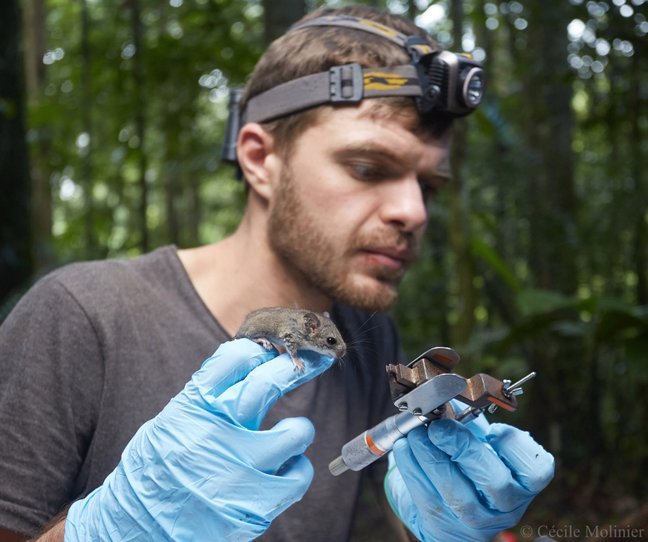Stuttgart, 07.09.2023. The emergence of "warm-bloodedness" was a milestone in the evolution of mammals: The ability to maintain a high and constant body temperature enabled the colonisation of new habitats even in harsh environments. Of particular interest, therefore, is the point in mammalian evolution at which warm-bloodedness arose. Since the so-called "maxilloturbinal" - a bone structure in the nasal cavity - contributes to thermoregulation, it has been proposed that it plays an important role in the development of warm-bloodedness.
However, an international team led by Dr. Quentin Martinez of the State Museum of Natural History Stuttgart has now shown that there is no direct relationship between the structure of the maxilloturbinal and the body temperature or metabolic rate. They thus call into question some of the previous hypotheses. For their research, the team took micro-CT images of the skulls of more than 300 mammalian species. Their findings were published in the scientific journal “Nature Communications”.
Skulls of over 300 animal species scanned
To test the relationship between the structure of the turbinate, body temperature and metabolic rate, Dr. Martinez and his team scanned skulls from 310 different mammal species using micro-computed tomography. The skulls came from the collections of several international museums and cover a wide variety of mammals. The images were used to visualize the maxilloturbinals in 3D and to determine their surface area and structure. Subsequently, the data thus obtained were compared with the body temperatures and metabolic rates of the respective animals.
What mammalian noses reveal about "warm-bloodedness”
The detailed studies show that the relative surface area of the maxilloturbinal does not reflect the expected body temperature or metabolic rate in many animals. Mammalian species that maintain similar body temperatures can exhibit very marked differences in relative surface area. For example, naked mole-rats and sloths. Both species are known for their low body temperatures and poor thermoregulation. In contrast, while the relative surface area of naked mole-rats is among the smallest among mammals, the maxilloturbinal of sloths is more than three times larger than would be expected based on their low body temperature.
An unexpected result
“Previous studies on the warm-bloodedness of extinct mammals focused on the relative surface area of the maxilloturbinal to determine the metabolic rate and body temperature of the organisms. Our results, however, show that this is a rather inaccurate approach. We concluded that there is no evidence to support a relationship between the origin of warm-bloodedness and the development of the maxilloturbinal” says Dr Martinez.
Editorial information:
Original publication:
Martinez, Q., Okrouhlík, J., Šumbera, R. et al. 2023. Mammalian maxilloturbinal evolution does not reflect thermal biology. Nature Communications, 14, 4425.
DOI: 10.1038/s41467-023-39994-1
https://www.nature.com/articles/s41467-023-39994-1
Publication date: 21.07.2023
State Museum of Natural History Stuttgart:
The State Museum of Natural History Stuttgart is a forward-looking research and communications institute. Its collections, the archives of biodiversity, contain over 12 million objects. The museum researches the evolution of life, analyses the biodiversity of different ecosystems and communicates research findings to the general public.
www.naturkundemuseum-bw.de
The maxilloturbinal - the heat exchanger in the head
Although "warm-bloodedness" (endothermy) is one of the most important and successful adaptations of mammals, studying its evolution is often challenging. Fossil remains usually have few features that allow assumptions about the animals' body temperature or heat production (metabolic rate). One of these features is the construction of the nasal cavity and the bony structures it contains, such as the maxilloturbinal. This bony system supports an epithelium involved in heat and moisture conservation. The tissue around these bony structures warms inhaled air and cools exhaled air. In addition, it removes moisture from exhaled air, thus helping to reduce heat and water loss. In this context, the larger the surface area of the inferior turbinate, the more heat can be conserved. Accordingly, it has been proposed that the evolution of these structures must be closely linked to the evolution of endothermy.
Contact for technical information:
Dr. Quentin Martinez
State Museum of Natural History Stuttgart, Germany
Tel. +49/(0)711/89 36/178
E-mail: quentin.martinez(at)smns-bw.de
Dr. Quentin Martinez is available for further information and interviews.
Press contact:
Meike Rech
State Museum of Natural History Stuttgart, Germany
Phone +49/(0)711/8936/107
E-mail: meike.rech(at)smns-bw.de
Images:
Image 1: Image1_Quentin_Martinez_Copyright_Cécile_Molinier.jpg
Description: Dr Quentin Martinez with a small rodent during field work.
Copyright notice: Cécile Molinier
Image 2: Image2_3D_CT-scans_mammal_skulls_Copyright_Quentin_Martinez.jpg
Description: 3D reconstructions of several CT-scanned mammal skulls. The maxilloturbinals are highlighted in violet.
Copyright notice: Quentin Martinez, SMNS
Image 3: Image3_Naked_mole_rat_Copyright_Quentin_Martinez.jpg
Description: A naked mole-rat. Skulls of naked mole-rats were scanned in the study. They have small maxilloturbinals and poor thermoregulation.
Copyright notice: Quentin Martinez, SMNS
Please note that use of the image material is only permitted to promote this research and only with copyright notice. Thank you very much.
